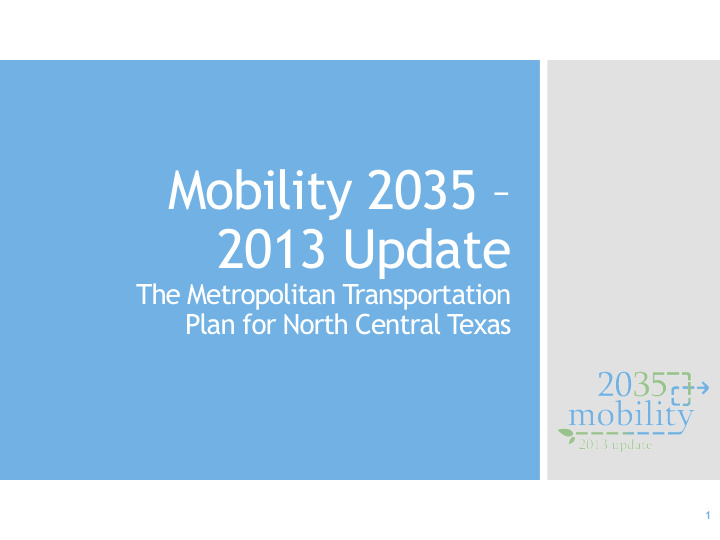



Mobility 2035 – 2013 Update The Metropolitan Transportation Plan for North Central T exas 1
Represents a blueprint for the region’s multimodal transportation What is the system Mobility 2035 – 2013 Update? Covers at least a 20-year timeframe Responds to goals Identifies policies, programs, and projects for continued development Guides the expenditure of federal and state funds 2
Mobility • Improve the availability of transportation options for people and Mobility 2035 – goods. • Support travel efficiency measures and system enhancements 2013 Update targeted at congestion reduction and management. • Assure all communities are provided access to the regional Goals transportation system and planning process. Quality of Life • Preserve and enhance the natural environment, improve air quality, and promote active lifestyles. • Encourage livable communities that support sustainability and economic vitality. System Sustainability • Ensure adequate maintenance and enhance the safety and reliability of the existing transportation system. • Pursue long-term, sustainable revenue sources to address regional transportation system needs. Implementation • Provide for timely project planning and implementation. • Develop cost-effective projects and programs aimed at reducing the costs associated with constructing, operating, and maintaining the regional transportation system. 3
Major Policy Needs exceed Can’t build our way Objectives available revenue out of congestion Use sustainable Emphasize development environmental aspects strategies to: and quality of life • Reduce demand on the issues of programs and transportation system projects • Provide multimodal options Maximize existing Invest strategically in system infrastructure 4
Funding Basics Regional System Facility Local Transportation Revenue Revenue Revenue System • Motor Fuel • Sales or Taxes Special • Tollroads • Vehicle Taxes • Managed Registration • Bond Lanes Fees Programs • Public • Other • Impact Fees Private Federal • Property Partnerships Sources Taxes • Other State • Value Sources Capture 5
Infrastructure Maintenance Prioritization Maximize Existing System $28.9 • Maintain & Operate Existing Facilities • Bridge Replacements and Management and Operations Expenditures $4.8 • Improve Efficiency & Remove Trips from System • Traffic Signals and Bicycle & Pedestrian Improvements Growth, Development, and $3.9 Land Use Strategies More Efficient Land Use & Transportation Balance Rail and Bus $15.6 Strategic Infrastructure Induce Switch to Transit Investment HOV/Managed Lanes Increase Auto Occupancy $45.5 Freeways/Tollways and Arterials Additional Vehicle Capacity Mobility 2035 – 2013 Update Expenditures $98.7 * *Actual dollars, in billions 6
Major Planned Roadway Improvements By 2035, there will be an additional 2,200 lane miles of freeways, tollways, and tolled managed lanes. 7
Priced Facilities These facilities play an important role in expediting project delivery and accommodating growing demand. 8
Planned Arterial Improvements Arterials complement major roadway and transit systems. The arterial system carries about 20% of all vehicular traffic in the region. 9
Roadway Corridors for Further Evaluation These corridors may be included in future MTPs, but first they will be subject to a thorough project development process. 10
Major Planned Rail Improvements By 2035, the region will have approximately 500 miles of passenger rail. 11
High/Higher Speed Passenger Rail The region is poised to benefit from HSR improvements. The RTC supports an integrated corridor concept that will serve both out of and in region demand. 12
Rail Corridors for Further Evaluation These corridors may be included in future MTPs, but first they will be subject to a thorough project development process. 13
Planned Off-street Bicycle and Pedestrian Improvements By 2035, the Regional Veloweb will expand to nearly 1,730 miles. 14
Regional 2035 Performance 2013 2035 Regional No-build Measures Performance Population 6,778,201 9,833,378 9,833,378 Measures Employment 4,292,516 6,177,016 6,177,016 Vehicle Miles of Travel 181,516,746 281,580,581 254,040,569 (Daily) Hourly Capacity 42,593,607 51,288,092 42,244,036 (Miles) Vehicle Hours Spent in 1,165,512 2,489,440 2,879,883 Delay (Daily) Increase in Travel Time Due to 32.1% 44.9% 56.2% Congestion Annual Cost of $4.7 $10.1 $11.7 Congestion (Billions) 15
2013 Congestion Levels Currently, many areas in North Central Texas experience some level of reoccurring congestion. 16
2035 Congestion Levels Despite planned improvements, congestion will continue to increase. This is the result of continued growth and declining revenue for transportation projects. 17
2035 No-build Congestion Levels Without the planned transportation improvements, congestion in the region would increase substantially. 18
For More Information To find out more about the Mobility 2035 – 2013 Update, visit us at: www.nctcog.org/mobility2035 Or e-mail comments and questions to: mobilityplan@nctcog.org 19
Recommend
More recommend